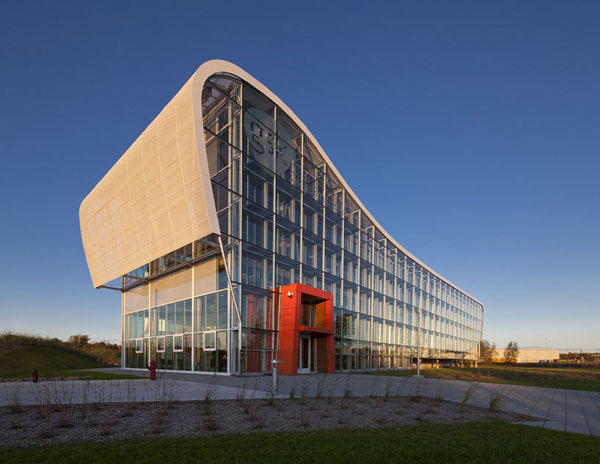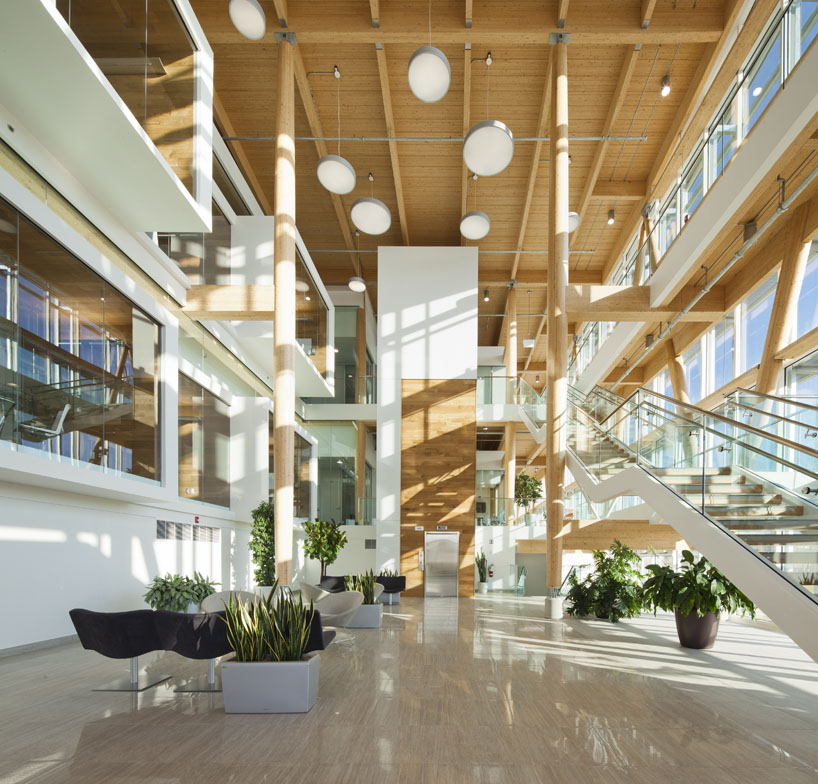The Glaxo Smith Kline administrative building in Quebec City, Canada — designed by coarchitecture, a local firm, and completed in 2011 — is a building with a mission to promote sustainable design in the workplace. Combining passive solar green building principles with systems and practices that enhance and enrich the surrounding landscape, it illustrates a number of ways in which our workplaces can become greener, more healthful, and maybe even beautiful.
The building (which comes to us via Designboom) was constructed around the principles of bioclimatic design, which relies heavily on passive heating and cooling strategies appropriate to the climate while paying special attention the comfort of the building’s inhabitants and the health of the surrounding landscape. Toward that end, the building relies on a combination of its site orientation and a strategic use of different types of glazing on each of its four facades to achieve a carbon neutral profile.

The building protects against solar heat gain during the summer via a system of sunshades on its south-facing side integrated into a fully-glazed, double-skinned envelope. As an added precaution, the administrative building’s main work areas were placed on the north side to shield them from glare and fluctuations in solar radiation, and to provide an unobstructed view of the surrounding landscape. (Full transparency on the south side also permits the exposure of the building’s wooden skeleton, whose frames were refined to express the warm, organic character the company was looking for.)
One of the principles of bioclamatic design is the primary reliance on the sun for heating the building during the winter and for daylighting year round. To help achieve this, those sunshades are opened up during the winter months, allowing light and heat to enter the building; the building envelope on the north side was also designed to conserve energy during this time of year, as were the translucent metal panels that clad the east and west sides of the building.

What heat the building requires beyond that supplied by the sun comes via an efficient radiant heating system (which also, conveniently, helps to soundproof the wooden decking on the lower level, ensuring a quieter work environment). Chilled beams and acoustic panels that diffuse sunlight light come together in a custom system that allows the richness of the structural wood to be seen without compromising the quality of the acoustics in the building.
The building’s south side features interactive spaces and lounges where occupants are encouraged to take their breaks and socialize and relax. Care was taken here to ensure that temperatures in these spaces can be adjusted via natural ventilation and daylighting. By spending time away from their desks in an area flooded with sunlight, staff members have access to a form of on-site light therapy.
The site on which the building is located, formerly lacking in soil quality and largely devoid of vegetation, was restored using native, drought-tolerant plants. The company even went so far as to replenish the local groundwater table to help ensure the health of those plants and the landscape in general for the long term.